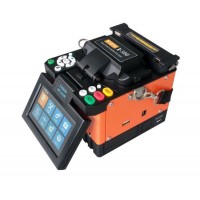No products
New products
-

BlackCopper BC-EGP-10G015-Z
Transform Your Business with BlackCopper BC-EGP-10G015-Z Dual Screen POS...
Rs 0
Catalog
Fusion Splicers: A Comprehensive Guide
Fusion splicing is a critical technique in fiber optic communication, offering a reliable and permanent connection for high-performance networks. Fusion splicers play a pivotal role in this process, enabling precision alignment and fusion of fiber optic cables. This comprehensive guide delves into the int...
Fusion Splicers: A Comprehensive Guide
Fusion splicing is a critical technique in fiber optic communication, offering a reliable and permanent connection for high-performance networks. Fusion splicers play a pivotal role in this process, enabling precision alignment and fusion of fiber optic cables. This comprehensive guide delves into the intricacies of fusion splicers, providing valuable insights for anyone involved in fiber optic installation or maintenance.
Understanding Fusion Splicers
A fusion splicer is an advanced tool that utilizes an electric arc to melt and fuse the ends of two fiber optic cables. This process results in a strong and durable connection, minimizing signal loss and ensuring optimal data transmission.
Types of Fusion Splicers
Fusion splicers come in various types, each designed for specific applications and requirements. Some common types include:
- Handheld Fusion Splicers: Compact and portable, ideal for field installations and on-site repairs.
- Benchtop Fusion Splicers: Larger and more robust, suitable for high-volume splicing operations in controlled environments.
- Automated Fusion Splicers: Offer increased speed and precision, often used in manufacturing and production lines.
Key Features and Components
Fusion splicers typically consist of these essential components:
- Fiber Cleaver: Precisely cleaves the ends of fiber optic cables to ensure a clean and smooth surface for fusion.
- Fiber Alignment System: Accurately aligns the cleaved fiber ends for optimal fusion.
- Fusion Arc Generator: Generates a controlled electric arc to melt and fuse the fibers.
- Microscope: Allows visual inspection of the fusion process and quality control.
- Control Panel: Facilitates operation and adjustment of splicing parameters.
Fusion Splicing Process
The fusion splicing process involves several steps to ensure a successful and reliable connection:
- Fiber Preparation: Clean and prepare the fiber ends using a fiber cleaver to achieve a precise and clean surface.
- Fiber Alignment: Utilize the alignment system to accurately position the cleaved fiber ends for proper fusion.
- Arc Discharge: Initiate the electric arc to melt and fuse the fiber ends together, creating a strong bond.
- Visual Inspection: Inspect the fusion joint using a microscope to ensure its quality and integrity.
- Testing: Conduct optical power measurements and other tests to confirm the quality of the connection.
Benefits of Fusion Splicing
Fusion splicing offers numerous advantages over other fiber connection methods, making it the preferred choice in high-performance networks:
- Low Loss: Fusion splicing minimizes signal loss, ensuring high data transmission speeds.
- High Reliability: Provides a permanent and robust connection, reducing the risk of signal degradation or connection failures.
- Versatility: Applicable to various fiber types and sizes, including single-mode and multimode fibers.
- Durability: Fusion spliced connections can withstand extreme temperatures and environmental conditions.
- Long-Term Performance: Ensures long-term reliability and performance, minimizing the need for maintenance or replacements.
Fusion Splicers and MB Communication
MB Communication recognizes the crucial role of fusion splicing in ensuring high-quality fiber optic networks. We offer a wide range of fusion splicing solutions, catering to diverse needs and applications. Our expertise and commitment to customer satisfaction have made us a trusted partner in the fiber optic industry.
Conclusion
Fusion splicing is an indispensable technology for creating reliable and high-performance fiber optic networks. Fusion splicers play a critical role in this process, enabling precise alignment and fusion of fiber optic cables. Understanding the various types, features, and applications of fusion splicers is crucial for anyone involved in fiber optic installation or maintenance.
MB Communication remains committed to providing innovative and reliable fusion splicing solutions, empowering our customers to build robust and future-proof fiber optic networks.
Fusion Splicer There are 6 products.
-
Shinho X-500
Shinho X-500 Handheld FTTX/FTTH Fiber Fusion Splicer Splicing Machine
Rs 152,880Out of stock -
-
Shinho X-600
Mini Fusion Splicer Kit PAS image digital processing system, core to core alignment Arc calibrated by temperature and pressure parameters 7 seconds typical splicing and 26 seconds heating time Metro style GUI, easy operation Intelligent operation, auto heating and fusing High definition 4.3'' colorful LCD
Rs 165,110Out of stock -
Shinho X-97
Shinho X-97 Fiber Optic Fusion Splicer Optical Fiber Fusion Splicing Machine
Rs 171,220Out of stock -
-










